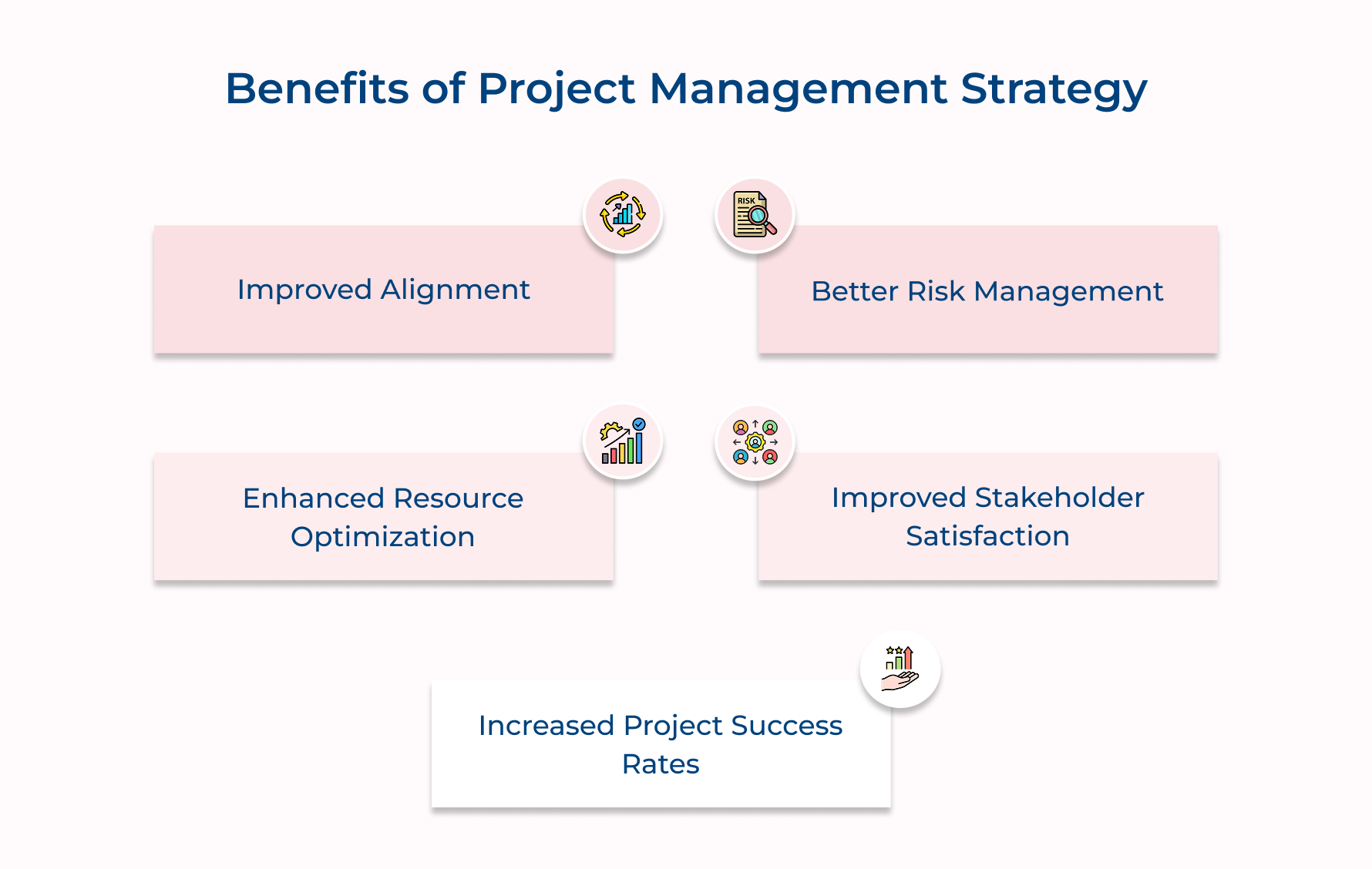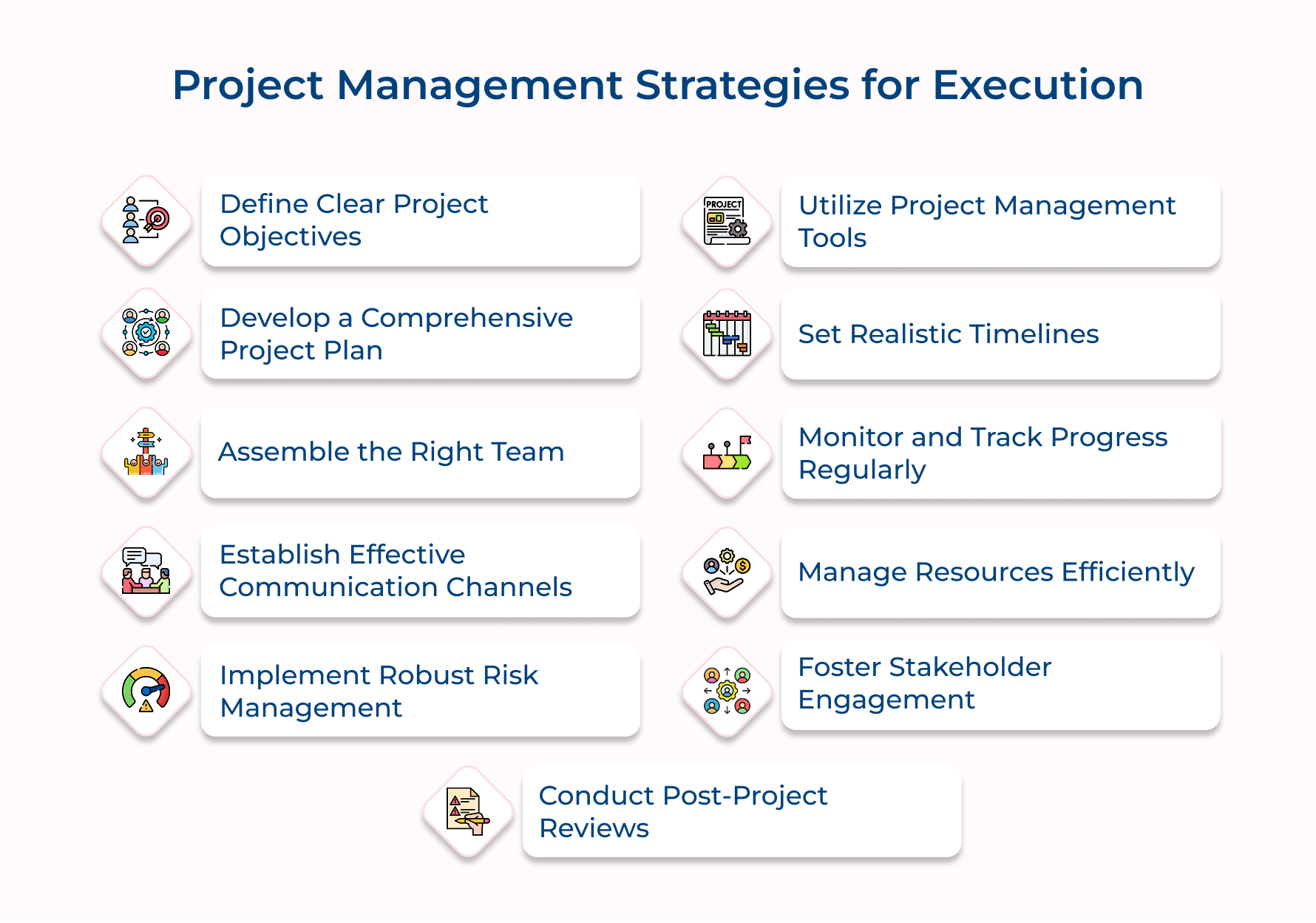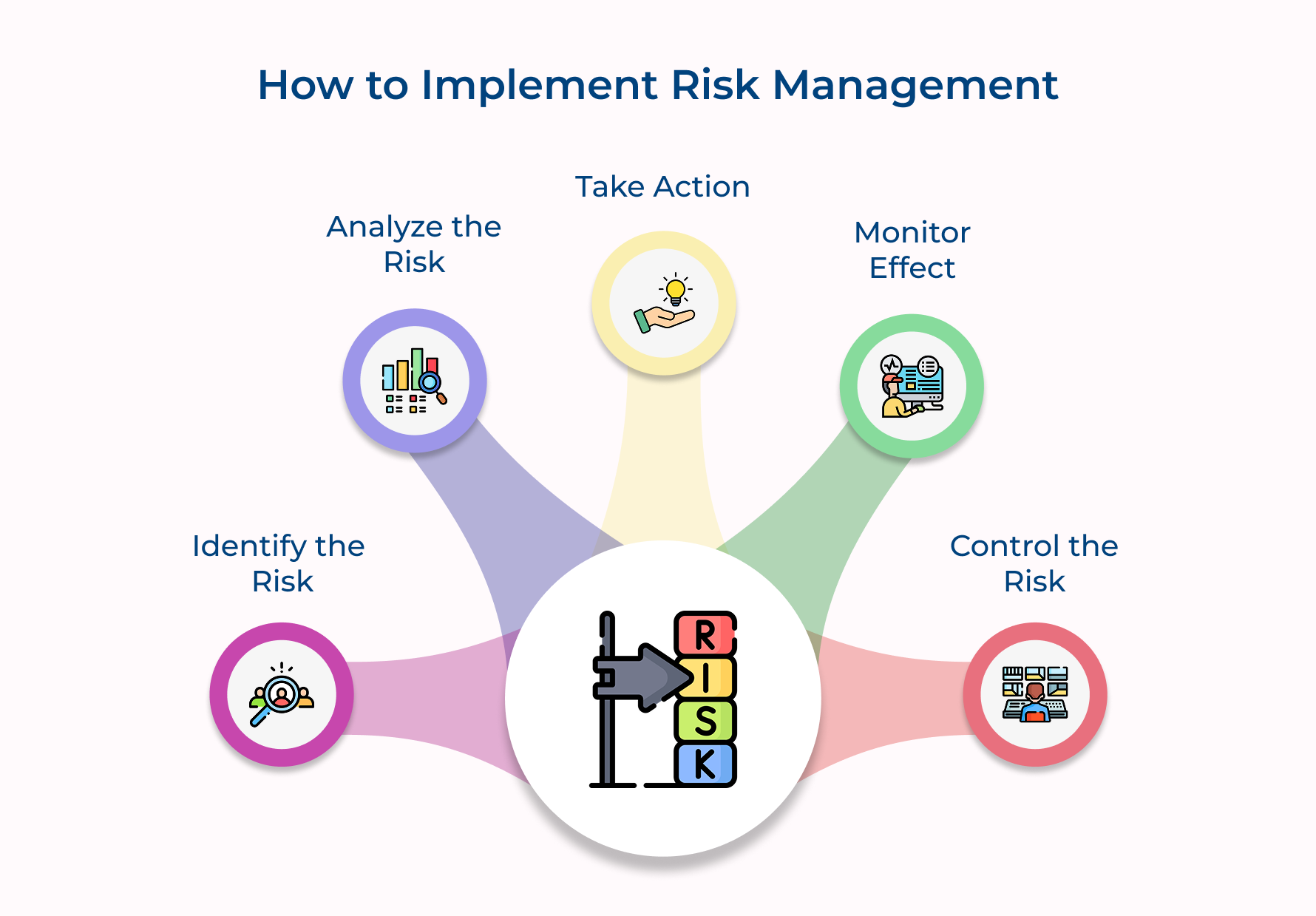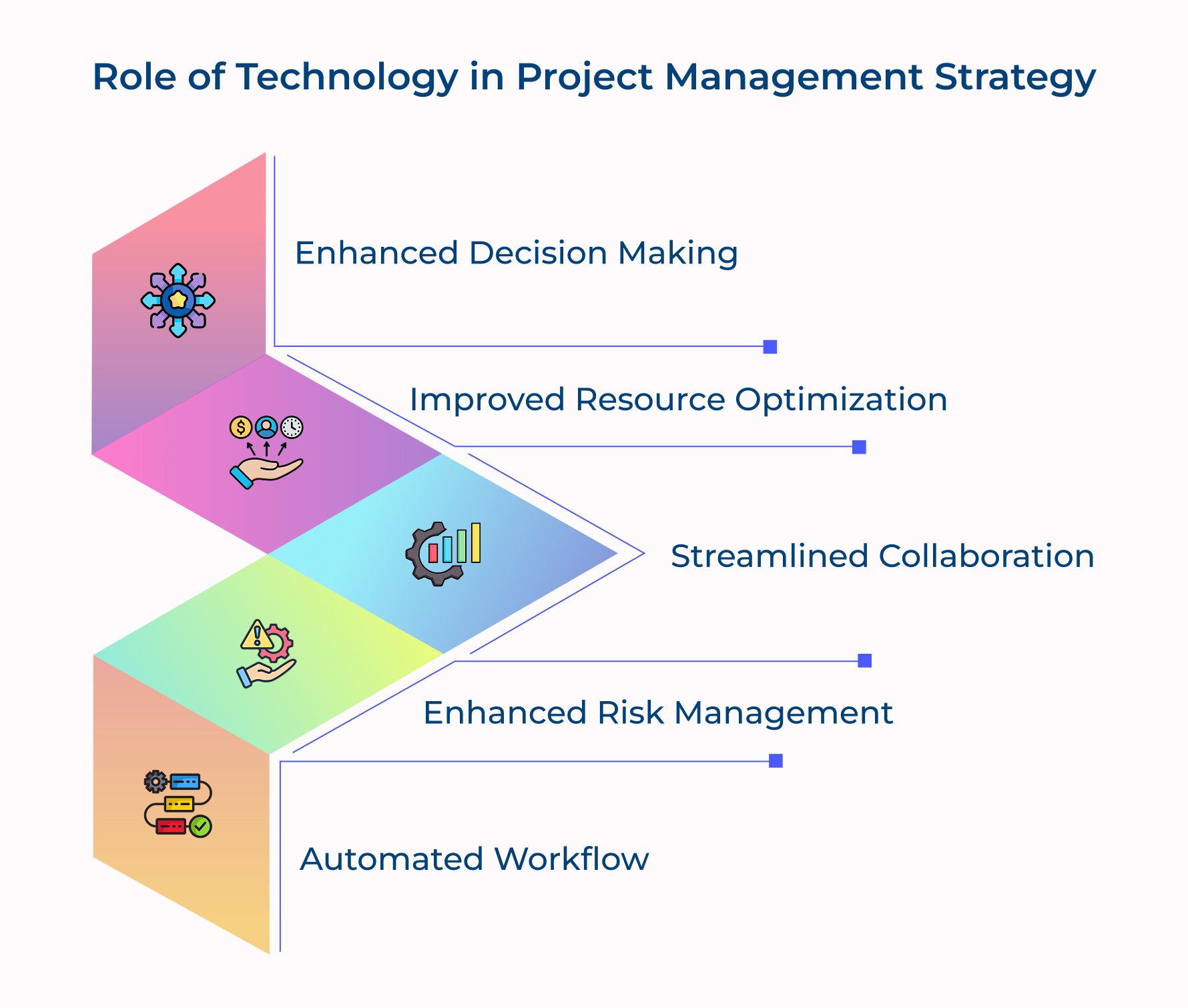11 Best Project Management Strategies for Business Growth
- What are Project Management Strategies?
- Key Benefits of Effective Strategic Project Management
- 11 Project Management Strategies for Successful Execution
- How Technology Can Improve Strategic Project Management
- Best Practices Every Successful Project Manager Should Follow
- Maximize Client Success with the Right Project Management Strategies
- FAQs about Successful Project Management Strategies

Key Highlights
89% of the companies have at least one project management office! Wonder why it is important? With multiple clients, tight deadlines, and ever-changing scopes, many project managers find themselves struggling to keep all the balls in the air.
Projects can quickly spiral out of control without effective strategies in place. But it doesn’t have to be this way. By implementing the right project management strategies, you can transform chaos into order and uncertainty into success.
We deep dive into the proven project management strategies that will help you manage the project life cycle with precision, efficiency, and confidence. Regardless of whether you’re managing a small creative team or overseeing complex consulting engagements, these strategies will equip you enough to deliver exceptional results.
What are Project Management Strategies?
Project management strategies are comprehensive approaches designed to guide the execution, monitoring, and completion of projects. These strategies encompass a set of methodologies that project managers employ to effectively organize resources, manage timelines, mitigate risks, and achieve project goals. They provide a structured framework for decision-making and problem-solving throughout the project lifecycle, from initiation to closure.
Project management strategies serve as a roadmap for project success. It ensures that all team members are aligned with the project’s objectives and working cohesively towards common goals. They also enhance communication among stakeholders, building transparency and accountability. This systematic approach not only increases the likelihood of project success but also contributes to organizational learning, as insights and best practices from one project can be applied to future endeavors.
Key objectives:
- Ensure project completion within the defined scope, time, and budget constraints.
- Maximize resource utilization and team productivity throughout the project lifecycle.
- Minimize risks and effectively manage unforeseen challenges that may impact project outcomes.
- Deliver high-quality results that meet or exceed stakeholder expectations and business objectives.
Key Benefits of Effective Strategic Project Management
Effective strategic project management aligns projects with business goals, ensuring resources are optimized and outcomes deliver real value. Let’s explore its key benefits:
1. Improved Alignment with Organizational Goals
Strategic project management ensures that all projects are directly tied to the organization’s overarching objectives. By aligning project outcomes with business goals, companies can focus their efforts on initiatives that deliver the most value. This alignment helps in prioritizing projects, allocating resources more effectively, and ensuring that every project contributes to the company’s strategic vision.
2. Enhanced Resource Optimization
Effective strategic project management leads to better allocation and utilization of resources, including human capital, finances, materials, etc. When managers have a clear overview of all projects, they can distribute resources more efficiently. The optimization reduces bottlenecks, and minimizes idle time, all while ensuring that critical assets are available when necessary. It also identifies conflicts early to take a proactive resolution.
3. Increased Project Success Rates
Strategic project management significantly improves the likelihood of project success. Previous project’s lessons and pitfalls help companies reduce repeating common pitfalls. This approach leads to more accurate project planning, better execution, and improved ability to meet deadlines as well as budgets. Strategic management allows for better tracking of project progress, enabling timely interventions when issues arise.
4. Better Risk Management
A key component of strategic project management is comprehensive risk assessment and mitigation. By identifying potential risks early in the project lifecycle, organizations develop contingency plans and implement preventive measures. A proactive approach improves the organization’s ability to handle uncertainties and adapt to changing circumstances without derailing project objectives.
5. Improved Stakeholder Satisfaction
Strategic project management emphasizes clear communication and expectation management with all stakeholders. Stakeholders involvement throughout the project lifecycle translates to building trust while maintaining support for their initiatives. Transparency leads to better relationships with clients, team members, and other involved parties, resulting in higher satisfaction levels as well as an increased likelihood of future collaborations.
11 Project Management Strategies for Successful Execution
71% of US companies are utilizing agile methodologies for project management. Let’s look into successful strategies that’ll help you elevate the competitive level of your company.
1. Define Clear Project Objectives and Scope
Defining clear project objectives provides direction and focus for the entire project. Without clear scope, teams can easily become sidetracked or work on tasks that don’t contribute to the desired outcome. A well-defined scope helps manage expectations, prevent scope creep, and ensures that all stakeholders have a shared understanding of the project’s boundaries.
Start by identifying the project’s primary goals and desired outcomes. Outline what is included in the project scope and the aspects that aren’t. Use this information to create a project charter or statement of work that serves as a reference point throughout the project lifecycle. Regularly review and update as needed.
Best practices:
- Use the SMART criteria (Specific, Measurable, Achievable, Relevant, Time-bound) when defining objectives to ensure clarity.
- Involve key stakeholders in the scope definition process and ensure all perspectives are considered.
- Document the project scope in detail, including deliverables, constraints, and assumptions, to avoid misunderstanding later in the project.
2. Build a Comprehensive Project Plan
A comprehensive project plan outlines how the project will be executed, monitored, and controlled. Without a thorough plan, teams may lack direction, miss important deadlines, or overlook critical tasks. A well-developed plan helps in coordinating efforts, allocating resources effectively, and managing stakeholder expectations throughout the project timeline.
Create a detailed project plan that includes tasks, timelines, milestones, resource requirements, and dependencies. Use this plan to guide daily activities, track progress, and make informed decisions. Share it with team members and stakeholders to ensure everyone is aligned on the project’s direction as well as progress.
Best practices:
- Use a Work Breakdown Structure (WBS) to break down the project into manageable components.
- Incorporate buffer time into the schedule to account for unexpected delays or challenges.
- Review the project plan regularly, involving team members to ensure it remains accurate throughout the project timeline.
3. Assemble the Right Team
Assembling the right team is crucial for project success because the team’s skills, experience, and dynamics directly impact project outcomes. A well-composed team ensures that all aspects of the project are covered and that team members can collaborate effectively to achieve project goals.
Start by identifying the skills and expertise required for the project. Look for team members who not only have the necessary technical skills but also possess soft skills like communication, adaptability, etc. Consider team dynamics and how different personalities will work together. Assign roles and responsibilities based on individual strengths.
Best practices:
- Conduct thorough assessments of potential team members, considering both technical skills and cultural fit within the project team.
- Create a diverse team with complementary skills and perspectives to build innovation as well as problem-solving capabilities.
- Implement a clear onboarding process for new team members to ensure they quickly understand their roles and the project objectives.
4. Establish Effective Communication Channels
Clear and timely communication is the lifeblood of successful project management. It ensures that all team members as well as stakeholders are informed, aligned, and can collaborate efficiently. Effective channels help in disseminating information, gathering feedback, and making informed decisions throughout the project lifecycle.
Implement a variety of communication tools and methods tailored to your team’s needs as well as preferences. This might include regular team meetings, project management software, instant messaging platforms, and email updates. Establish clear guidelines for which channels should be used for different types of communication.
Best practices:
- Implement a centralized project communication platform where all project-related discussions can be easily accessed and tracked.
- Establish regular check-ins and status update meetings to ensure consistent information flow along with early identification of issues.
- Encourage transparent communication within the team, creating an environment where members feel comfortable sharing ideas and concerns.
5. Implement Robust Risk Management
Implementing robust risk management helps identify, assess, and mitigate potential threats to project success. Without proper risk management, projects are vulnerable to unforeseen issues that can cause delays, budget overruns, or even project failure. A proactive approach to risk management allows teams to anticipate challenges and develop strategies to address them.
Conduct a thorough risk assessment at the beginning of the project. Identify potential risks, evaluate their likelihood as well as potential impact, and prioritize them. Develop mitigation strategies for high-priority risks. Regularly review the risk register throughout the project lifecycle. Assign risk owners to monitor specific risks and implement mitigation plans when necessary.
Best practices:
- Use a structured risk assessment framework, such as SWOT analysis or PESTLE analysis, to identify a comprehensive range of potential risks.
- Develop contingency plans for high-impact risks to ensure quick and effective responses if these risks materialize.
- Create a risk-aware culture within the team, encouraging everyone to identify and report potential risks.
6. Utilize Project Management Tools and Software
Utilizing project management tools streamline processes, improve collaboration, and provide real-time visibility into project progress. They enable efficient task management, resource allocation, and reporting. Without appropriate tools, project managers may struggle to keep track of multiple aspects of the project.
Select tools that align with your project’s needs and team’s capabilities. Implement software for task management, scheduling, resource allocation, and reporting. Encourage team members to update their progress regularly within the system. Leverage data from these tools to make informed decisions and adjust strategies as needed.
Best practices:
- Choose user-friendly tools that integrate well with existing systems to ensure high adoption rates among team members.
- Provide thorough training on the selected tools to ensure all team members can utilize them effectively.
- Regularly optimize the use of tools, soliciting feedback from the team to identify areas for improvement or additional features needed.
7. Set Realistic Timelines and Milestones
Unrealistic timelines can lead to rushed work, compromised quality, and team burnout. Well-defined milestones serve as checkpoints to assess progress, celebrate achievements, and make necessary adjustments. They help maintain momentum as well as keep the project on track toward its objectives.
Estimate the time required for each task, considering team capacity and potential obstacles. Set milestones at key points in the project lifecycle. Use these timelines and milestones to create a project schedule, allocate resources, as well as set expectations with stakeholders. Review progress against the timeline and adjust as needed.
Best practices:
- Involve team members in the estimation process to leverage their expertise and increase buy-in for the established timelines.
- Use historical data from similar projects to inform time estimates and improve accuracy.
- Build buffer time for unexpected delays or challenges, especially for critical path activities.
8. Monitor and Track Progress Regularly
Regular monitoring and tracking of progress helps identify issues early, as well as allows for timely course corrections. Regular tracking also helps maintain team accountability and provides valuable data for stakeholder reporting as well as decision-making.
Implement a system for regular progress updates, such as daily stand-ups or weekly status reports. Use project management software to track task completion, resource utilization, and overall project progress. Compare actual progress against the planned schedule and budget. Analyze variances to identify potential issues or areas needing attention.
Best practices:
- Establish clear metrics and key performance indicators (KPIs) to measure progress objectively as well as consistently throughout the project.
- Use visual tools like Gantt charts or burndown charts to make progress tracking more intuitive and accessible to all stakeholders.
- Conduct regular project health checks to assess not just task completion, but also quality, team morale, and alignment with project objectives.
9. Manage Resources Efficiently
Efficient resource management ensures that the right resources (people, equipment, materials) are available at the right time to complete project tasks. It optimizes utilization, reduces conflicts, and contributes significantly to project success. However, poor resource management affects team morale and productivity.
Create a resource plan that outlines when and where resources will be needed. Use resource management tools to allocate as well as track resource usage. Regularly review resource utilization and capacity to identify potential conflicts or overallocation. Consider cross-training team members to increase flexibility in resource allocation.
Best practices:
- Implement a resource forecasting system to anticipate future resource needs and plan accordingly.
- Regularly communicate with team members about their workload to ensure balanced resource allocation and prevent burnout.
- Establish a clear process for requesting and approving additional resources when needed to avoid delays in project execution.
10. Create Stakeholder Engagement and Buy-in
Building stakeholder engagement and buy-in is essential because stakeholders can significantly influence project success. Engaged stakeholders provide valuable input, support, and resources. Strong stakeholder engagement ensures that the project aligns with organizational goals and meets the expectations of all involved parties.
Identify all relevant stakeholders at the project’s outset. Develop a stakeholder management plan that outlines communication strategies for each stakeholder group. Involve key stakeholders in important decisions. Address concerns promptly as well as demonstrate the project’s value/progress to maintain support. Celebrate milestones and successes with stakeholders to reinforce their commitment.
Best practices:
- Conduct a thorough stakeholder analysis to understand each stakeholder’s interests, influence, and potential impact on the project.
- Tailor communication approaches to different stakeholder groups, ensuring that each receives relevant information in their preferred format.
- Establish a feedback loop with stakeholders to continuously gather input and address concerns throughout the project lifecycle.
11. Conduct Post-project Reviews and Learn from Experience
Conducting post-project reviews provides an opportunity to reflect on the project’s successes and challenges. The reviews help identify areas for improvement, validate effective practices, and capture lessons learned. It’s a key component of continuous improvement in project management.
Schedule a post-project review meeting soon after project completion. Involve all team members and key stakeholders. Discuss what went well, what could be improved, and any unexpected challenges faced. Document these insights in a lessons-learned report. Use this information to update project management processes, templates, and best practices.
Best practices:
- Create a safe, blame-free environment for the review to encourage honest and constructive feedback from all participants.
- Use a structured format for the review, such as the “Start, Stop, Continue” method, to ensure comprehensive coverage of all aspects of the project.
- Develop an action plan based on the review findings to ensure that lessons learned are implemented in future projects.
How Technology Can Improve Strategic Project Management
Over 90 million employees worldwide work in industries that focus on project management. Let’s explore how technology improves their project management methodologies.
1. Enhanced Decision Making through Data Analytics
Technology enables the collection and analysis of vast amounts of project data in real-time. Advanced analytics tools process this data to provide actionable insights, helping project managers make more informed decisions.
Predictive analytics can forecast potential outcomes based on historical data and current trends, allowing for proactive management. The data-driven approach enhances strategic decision-making, reduces risks, and increases the likelihood of project success.
2. Improved Resource Optimization
Resource management software provides a holistic view of resource allocation across multiple projects. These tools can analyze resource utilization, identify bottlenecks, and suggest optimal allocation strategies.
Leveraging AI and machine learning helps predict future resource needs as well as potential conflicts. This level of insight allows for strategic resource planning, ensuring that the right skills are available at the right time, maximizing efficiency, and reducing costs.
3. Streamlined Collaboration and Communication
Cloud-based project management platforms break down silos and facilitate seamless collaboration regardless of geographical location. They provide a centralized hub for all project-related communication, document sharing, and task management.
Real-time updates and notifications keep all stakeholders informed, reducing miscommunication as well as delays. Virtual meeting technologies further enhance remote collaboration, allowing for face-to-face interactions and building team cohesion even in distributed teams.
4. Enhanced Risk Management and Mitigation
Sophisticated risk management software identifies potential risks by analyzing project data and external factors. The tools can quantify risks, assess their potential impact, and suggest mitigation strategies.
Some advanced systems use AI to predict potential risks based on patterns from past projects. By providing early warning signs and actionable mitigation plans, technology enables a more proactive as well as strategic approach to risk management.
5. Automated Workflow and Process Optimization
Workflow automation tools streamline repetitive tasks, reducing manual errors and freeing up time for strategic activities. The systems can automate everything from task assignments to approval processes, ensuring consistency and efficiency.
Moreover, by analyzing workflow data, these tools identify inefficiencies in processes. This insight allows project managers to continuously optimize workflows, improving overall project efficiency and strategic alignment.
Best Practices Every Successful Project Manager Should Follow
1. Communicate Clearly and Consistently
Effective communication is the cornerstone of successful project management. Establish clear channels for team communication and stakeholder updates. Hold regular meetings to discuss progress, challenges, and next steps. Ensure that all team members understand their roles and responsibilities. Use a mix of communication methods, including face-to-face meetings, email updates, and project management software to keep everyone informed.
2. Set Realistic Goals and Expectations
Begin each project by setting clear, achievable objectives. Break down large goals into smaller, manageable tasks. Use the SMART criteria (Specific, Measurable, Achievable, Relevant, Time-bound) when setting goals. Be transparent about project constraints and potential challenges. Regularly review and adjust goals as needed, ensuring they remain aligned with the project’s overall objectives as well as stakeholder expectations.
3. Prioritize Risk Management
Identify potential risks early in the project lifecycle. Develop a comprehensive risk management plan that outlines strategies for mitigating each identified risk. Regularly review and update this plan throughout the project. Encourage team members to report potential risks promptly. Be prepared to implement contingency plans quickly when needed.
4. Build Team Collaboration and Development
Build a cohesive team by promoting a culture of collaboration and mutual respect. Encourage knowledge sharing as well as cross-functional cooperation. Provide opportunities for professional development and skill enhancement. Recognize and celebrate team achievements to boost morale as well as motivation. Address conflicts promptly and constructively to maintain a positive team dynamic.
5. Leverage Technology and Tools
Utilize project management software to streamline processes, improve efficiency, and enhance collaboration. Choose tools that fit your team’s needs and work style. Ensure all team members are trained in using these tools effectively. Regularly evaluate the effectiveness of your tools and be open to adopting new technologies that can improve project outcomes.
6. Practice Continuous Improvement
After each project, conduct a thorough post-mortem analysis. Identify what worked well and areas for improvement. Document lessons learned and share insights with the wider organization. Use this information to refine your project management approach continuously. Stay updated on industry best practices and emerging trends in project management. Encourage feedback from team members and stakeholders to identify areas where you can enhance your leadership as well as management skills.
Maximize Client Success with the Right Project Management Strategies
Service-based businesses must align project management with client outcomes and profitability to ensure sustainable growth as well as client satisfaction. Effective project management strategies are crucial for maximizing client success. By implementing robust planning, resource allocation, and performance tracking, businesses can meet client expectations efficiently as well as cost-effectively.
Ultimately, the synergy between project management along with client outcomes builds long-term relationships, enhances reputation, and drives business growth. It allows service-based businesses to differentiate themselves in a competitive market by consistently delivering superior results and value to their clients.
Limit time — not creativity
Everything you need for customer support, marketing & sales.
Neeti Singh is a passionate content writer at Kooper, where he transforms complex concepts into clear, engaging and actionable content. With a keen eye for detail and a love for technology, Tushar Joshi crafts blog posts, guides and articles that help readers navigate the fast-evolving world of software solutions.



